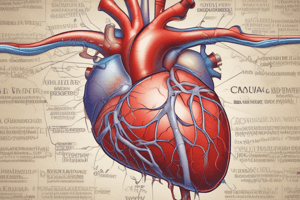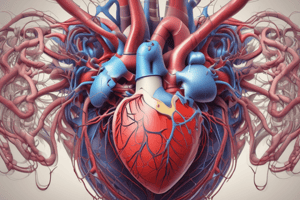Podcast
Questions and Answers
What type of bond connects monomers in carbohydrates?
What type of bond connects monomers in carbohydrates?
- Phosphodiester bond
- Ester bond
- Glycosidic bond (correct)
- Peptide bond
What is the primary purpose of ingestion in the digestive process?
What is the primary purpose of ingestion in the digestive process?
- Taking in of food (correct)
- Absorption of nutrients
- Breaking down food chemically
- Removing waste from the body
Which enzyme is responsible for breaking down proteins in the duodenum?
Which enzyme is responsible for breaking down proteins in the duodenum?
- Pepsin
- Amylase
- Lipase
- Erepsin (correct)
Which macronutrient is made up of fatty acid chains?
Which macronutrient is made up of fatty acid chains?
During which stage of digestion do nutrients enter the bloodstream?
During which stage of digestion do nutrients enter the bloodstream?
What is one of the primary functions of carbohydrates in biological systems?
What is one of the primary functions of carbohydrates in biological systems?
Which of the following is an example of a protein function?
Which of the following is an example of a protein function?
What is a primary function of lipids in the body?
What is a primary function of lipids in the body?
Which of the following is NOT a function of carbohydrates?
Which of the following is NOT a function of carbohydrates?
Which food is cited as an example of a protein source?
Which food is cited as an example of a protein source?
What is the primary function of the mucosa layer in the stomach?
What is the primary function of the mucosa layer in the stomach?
In which part of the digestive tract does chemical digestion primarily occur?
In which part of the digestive tract does chemical digestion primarily occur?
Which condition is associated with the entry of chyme into the esophagus?
Which condition is associated with the entry of chyme into the esophagus?
What is the primary purpose of mechanical digestion in the stomach?
What is the primary purpose of mechanical digestion in the stomach?
What role do antacids like Tums play in treating heartburn?
What role do antacids like Tums play in treating heartburn?
Which of the following layers of the stomach is responsible for reducing friction?
Which of the following layers of the stomach is responsible for reducing friction?
Which section of the small intestine is primarily involved in continued digestion?
Which section of the small intestine is primarily involved in continued digestion?
What symptoms are commonly experienced during gastroesophageal reflux?
What symptoms are commonly experienced during gastroesophageal reflux?
What is the primary function of the tricuspid valve in the heart?
What is the primary function of the tricuspid valve in the heart?
Which of the following accurately describes the role of the pulmonary semilunar valve?
Which of the following accurately describes the role of the pulmonary semilunar valve?
How does homeostasis aid in maintaining blood pH levels?
How does homeostasis aid in maintaining blood pH levels?
Which blood component is primarily involved in transporting oxygen?
Which blood component is primarily involved in transporting oxygen?
In what form is carbon dioxide primarily transported in the blood?
In what form is carbon dioxide primarily transported in the blood?
What is the role of the aortic semilunar valve?
What is the role of the aortic semilunar valve?
What is the most significant change in breathing rate observed when blood pH decreases?
What is the most significant change in breathing rate observed when blood pH decreases?
In a patient recovering from the flu, which hematocrit component is likely to show a decrease?
In a patient recovering from the flu, which hematocrit component is likely to show a decrease?
What is the primary function of the epiglottis during swallowing?
What is the primary function of the epiglottis during swallowing?
Which type of circulation is responsible for oxygenating blood?
Which type of circulation is responsible for oxygenating blood?
What role does the pancreas play in digestion?
What role does the pancreas play in digestion?
Which nutrient is primarily broken down by pepsin?
Which nutrient is primarily broken down by pepsin?
What characterizes the mucosa layer of the digestive tract?
What characterizes the mucosa layer of the digestive tract?
What is the main product of glycolysis in cellular respiration?
What is the main product of glycolysis in cellular respiration?
What is the primary role of the gallbladder in the digestive system?
What is the primary role of the gallbladder in the digestive system?
What type of fat is characterized by having no double bonds between carbon atoms?
What type of fat is characterized by having no double bonds between carbon atoms?
What is the primary function of the rectum in the digestive system?
What is the primary function of the rectum in the digestive system?
What is the function of vili and microvilli in the intestines?
What is the function of vili and microvilli in the intestines?
Study Notes
Heart Valves
- The tricuspid valve prevents backflow from the right ventricle to the right atrium.
- The pulmonary semilunar valve prevents backflow from the pulmonary arteries to the right ventricle.
- The bicuspid valve prevents backflow from the left ventricle to the left atrium.
- The aortic semilunar valve prevents backflow from the aorta to the left ventricle.
Homeostasis and Blood pH
- Homeostasis maintains balance in the body, including blood pH.
- When blood pH drops, the brain increases breathing rate, heart rate, and blood volume.
- This helps remove excess carbon dioxide, which normalizes blood pH.
Hematocrit Tubes
- Healthy Patient: Plasma makes up the largest portion of a hematocrit tube in a healthy patient. Leukocytes (white blood cells) are present in a smaller layer above the red blood cell (erythrocytes) layer
- Patient Recovering from Flu: The plasma layer will be smaller than the healthy patient, while the red blood cell layer will be larger due to the body fighting the infection. The Leukocyte layer will also be bigger as the body fights the infection with white blood cells
Carbon Dioxide Transport
- Carbon dioxide is transported through the blood in the blood plasma.
- It also combines with hemoglobin to form carbaminohemoglobin.
- Carbon dioxide can also form carbonic acid, which turns into bicarbonate ions.
Oxygen Transport
- Oxygen is transported through the blood in the blood plasma.
- Oxygen also combines with hemoglobin to form oxyhemoglobin.
Macronutrients
- Carbohydrates: Provide material to build cell membranes and provide quick energy for cells to use. Examples: potatoes
- Proteins: Build and repair muscles and bones, help in muscle movements. Examples: chicken, fish
- Lipids: Store energy for cells to use later, insulate internal organs, provide material to build cell membranes. Examples: eggs, olive oil.
Macronutrients - Chart
- Carbohydrates: Monomer: Simple sugars, Polymer: Polysaccharides, Bond: Glycosidic Linkage, Enzymes: Salivary Amylase, Pancreatic Amylase
- Proteins: Monomer: Amino acids, Polymer: Polypeptides, Bond: Peptide Bonds, Enzymes: Pepsin, Trypsin, Erepsin
- Lipids: Monomer: Fatty acid chains, Polymer: Triglycerides, Bond: Ester Linkage, Enzymes: Lipase.
Stages of Digestion
- Ingestion: Taking in food.
- Digestion: Physical and chemical breakdown of food.
- Absorption: Absorption of nutrients into the bloodstream.
- Egestion: Removal of waste through the anus.
Digestive Process Table
- Chemical Digestion: Breakdown of food into smaller molecules by enzymes. Occurs in the duodenum with enzymes like trypsin and lipase.
- Mechanical Digestion: Physical breakdown of food into smaller pieces. This process occurs in the mouth and stomach using teeth and churning.
Stomach Layers
- Mucosa: Produces digestive enzymes.
- Submucosa: Contains blood vessels and nerves.
- Muscularis: Churns food.
- Serosa: Outer layer to reduce friction.
Gastroesophageal Reflux Disease (GERD)
- Occurs when chyme enters the esophagus.
- Symptoms include heartburn, regurgitation, chest pain, and coughing.
- Antacids like Tums work by neutralizing the stomach acid.
Small Intestine
- The small intestine is divided into the duodenum, jejunum, and ileum.
- Duodenum: Receives chyme from the stomach and pancreatic juices.
- Jejunum: Major site of nutrient absorption.
- Ileum: Absorbs vitamins and bile salts.
Studying That Suits You
Use AI to generate personalized quizzes and flashcards to suit your learning preferences.
Related Documents
Description
This quiz covers essential topics in human anatomy, focusing on heart valves and their functions, as well as the body's process of maintaining homeostasis and blood pH. Additionally, it explores hematocrit tubes and their significance in determining health status. Test your understanding of these critical biological concepts.




